Disclaimer: New EUDR developments - December 2025
In November 2025, the European Parliament and Council backed key changes to the EU Deforestation Regulation (EUDR), including a 12‑month enforcement delay and simplified obligations based on company size and supply chain role.
Key changes proposed:
These updates are not yet legally binding. A final text will be confirmed through trilogue negotiations and formal publication in the EU’s Official Journal. Until then, the current EUDR regulation and deadlines remain in force.
We continue to monitor developments and will update all guidance as the final law is adopted.
Disclaimer: 2026 Omnibus changes to CSRD and ESRS
In December 2025, the European Parliament approved the Omnibus I package, introducing changes to CSRD scope, timelines and related reporting requirements.
As a result, parts of this article may no longer fully reflect the latest regulatory position. We are currently reviewing and updating our CSRD and ESRS content to align with the new rules.
Key changes include:
We continue to monitor regulatory developments closely and will update this article as further guidance and implementation details are confirmed.
It’s been just over three months since the EU published its Omnibus Proposal, meant to simplify sustainability reporting. But for many companies, it’s done the opposite. Instead of bringing clarity, uncertainty is growing.
In fact, during our recent webinar Three months into the Omnibus Proposal, over 70% of attendees cited uncertainty as their biggest challenge since Omnibus was announced—that is, not knowing where to focus, or whether to continue reporting at all.
Despite this, many major players, from H&M to Philips, are standing firm, continuing to demand ESG data from their entire value chain. This suggests that expectations haven’t shifted much in practice, and companies tend to agree.
In our recent 2025 Post-Omnibus Market Pulse Report, 90% of respondents said they plan to continue ESG reporting, even if it’s no longer mandatory. For many, it’s a strategic decision to protect credibility, meet stakeholder expectations, and keep ESG central to their business strategy.
If you’re still figuring out what the Omnibus Proposal means in real terms, and what your company should do next, then this article is for you.
We’ll walk you through what’s changed and what hasn’t, based on our personal conversations with politicians and lawmakers. We’ll also outline six clear steps to move forward, whether you’re just getting started or already adapting to the Corporate Sustainability Reporting Directive (CSRD) and related frameworks.
{{custom-cta}}
Published in February 2025, the Omnibus Proposal is a legislative package from the European Commission that bundles together a wide range of regulatory changes, primarily aimed at simplifying EU sustainability rules.
It introduces major rollbacks to laws like the CSRD, EU Taxonomy, and Corporate Sustainability Due Diligence Directive (CSDDD).
The Commission framed the proposal as a competitiveness measure, citing a 2024 report by Mario Draghi, former President of the European Central Bank, who was appointed by the EU to assess how Europe can boost economic resilience.
In his nearly 400-page report, Draghi argued that the EU’s regulatory environment is no longer fit to support long-term growth and global competitiveness.
But the Omnibus Proposal has faced strong criticism. Many argue that weakening sustainability regulations directly undermines the EU’s goal to reach net zero by 2050.
The Omnibus was also accompanied by the Stop the Clock directive, which allows reporting delays for some companies. For example, Wave 2 CSRD reporters now have up to two additional years before mandatory disclosures take effect.
So, what’s changed? One of the most significant impacts of the Omnibus Proposal lies in how it reshapes the CSRD, both in scope and complexity.

Under the original CSRD, companies with more than 250 employees were expected to report, with a phased rollout based on company size. The Omnibus now proposes raising that threshold to 1,000 employees, with some reports suggesting it could rise even further, to 3,000 or even 5,000.
While that’s still under debate, the immediate effect is clear: the number of companies covered by the CSRD would drop from around 50,000 to fewer than 7,000.
There are also changes to value chain reporting. Previously, companies were expected to gather ESG data from all entities in their value chain, regardless of whether those entities were themselves subject to CSRD.
The revised proposal limits this obligation. Now, only suppliers that are also CSRD-reporting entities will need to provide data.
Lastly, the concept of double materiality, a cornerstone of the CSRD, is also being reconsidered. While early commentary suggested it would remain intact, Coolset’s sustainability researcher, Jasper Akkermans, spoke with Wim Bartels, a member of EFRAG’s Sustainability Reporting Board, who indicated that streamlining is likely.
This could mean a more focused, simplified materiality assessment process, though final details are still emerging.
The Omnibus Proposal didn’t just appear out of nowhere. It moved through the EU’s legislative process at unusual speed, raising questions from policymakers, watchdogs, and businesses alike.
In Brussels, the debate is now in full swing. The European Parliament is split between two camps: one pushing for deregulation in the name of competitiveness, the other trying to preserve the EU’s climate and social ambitions.
Despite strong polarization, there is political will to reach an agreement, and remarkably, a final decision is expected as early as late 2025, a process that typically takes up to two years.
At the heart of this is a fragile four-party coalition: the European People’s Party (EPP), Socialists & Democrats (S&D), Renew Europe, and the European Greens.
Together, they hold a clear parliamentary majority (454 out of 720 seats) and aim to balance simplification with ESG integrity. But each party brings a different view to the table:
The EPP, the largest group with 188 seats, is driving efforts to raise reporting thresholds and ease compliance burdens, framing the proposal as a way to cut “red tape.”
“The big debate now is: will you stand for growth and jobs or red tape and bureaucracy?” – Tomas Tobé (EPP)
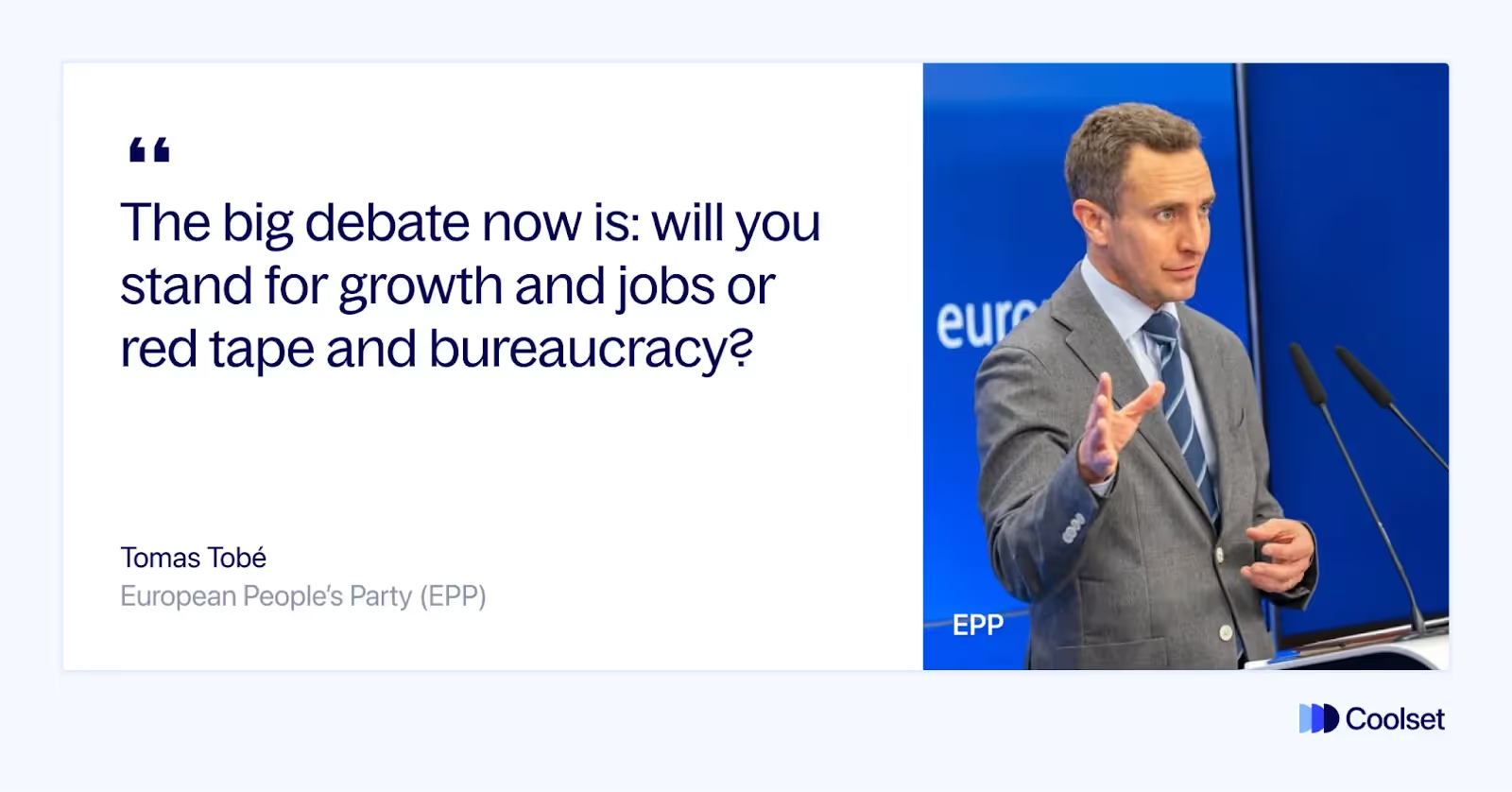
The S&D push back hard, defending environmental and social standards and warning against excessive exemptions that weaken corporate accountability.
The 136-seat party supports maintaining CSDDD climate and due diligence obligations and seeks compromises to preserve the Green Dealʼs core goals.
“This is not simplification, it’s obstructing justice. Removing liability for child labor and deforestation isn’t streamlining – it’s erasing accountability.” – Lara Wolters (S&D)
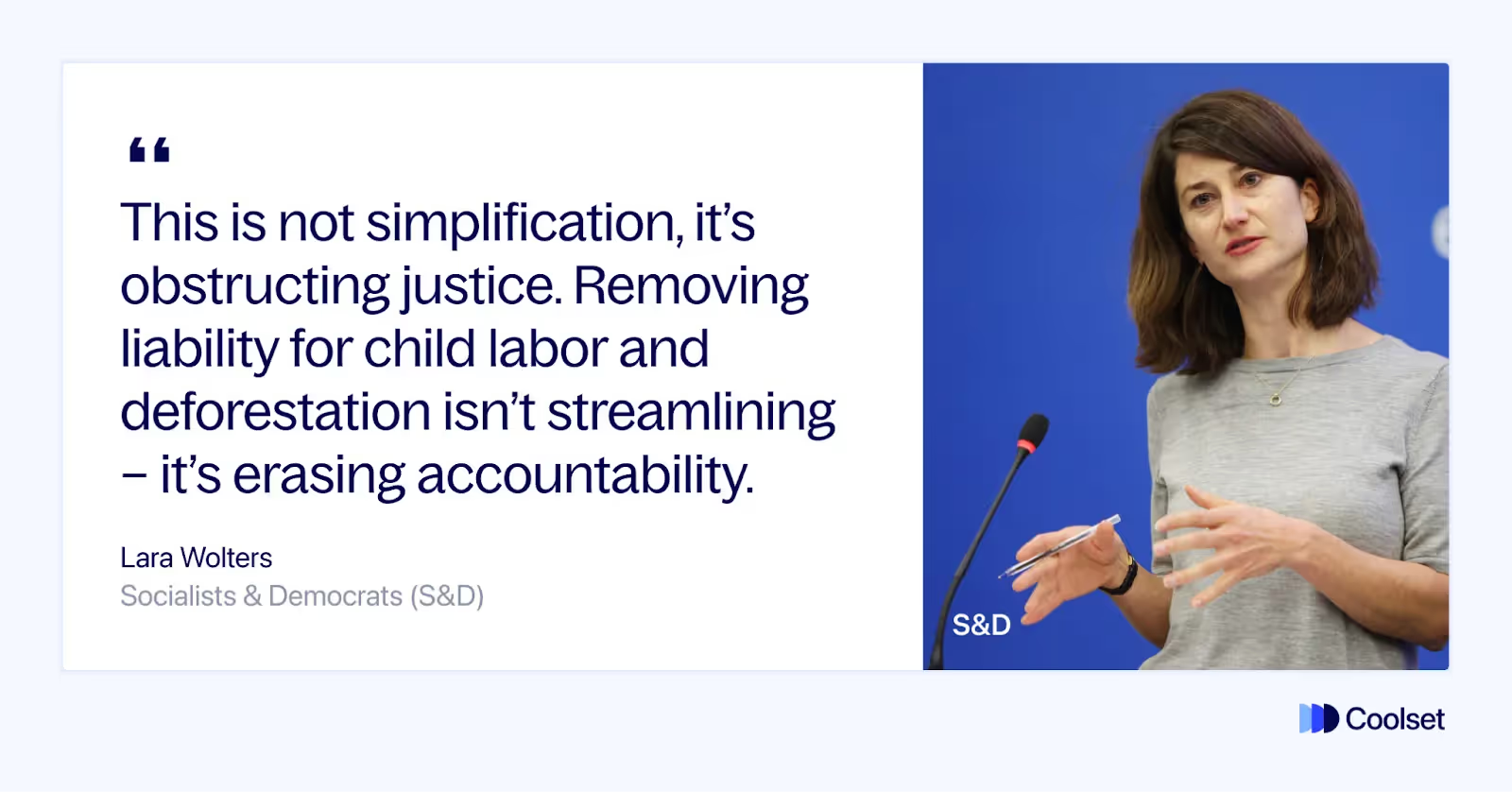
Renew Europe with 77 seats takes a middle-ground position. It focuses on practical implementation and calls for more legal clarity and alignment across frameworks without undermining core ESG goals.
“We need all kinds of new omnibuses. And the next one must be a digital omnibus, because we need to simplify the excessive digital laws.” – Svenja Hahn (Renew Europe)
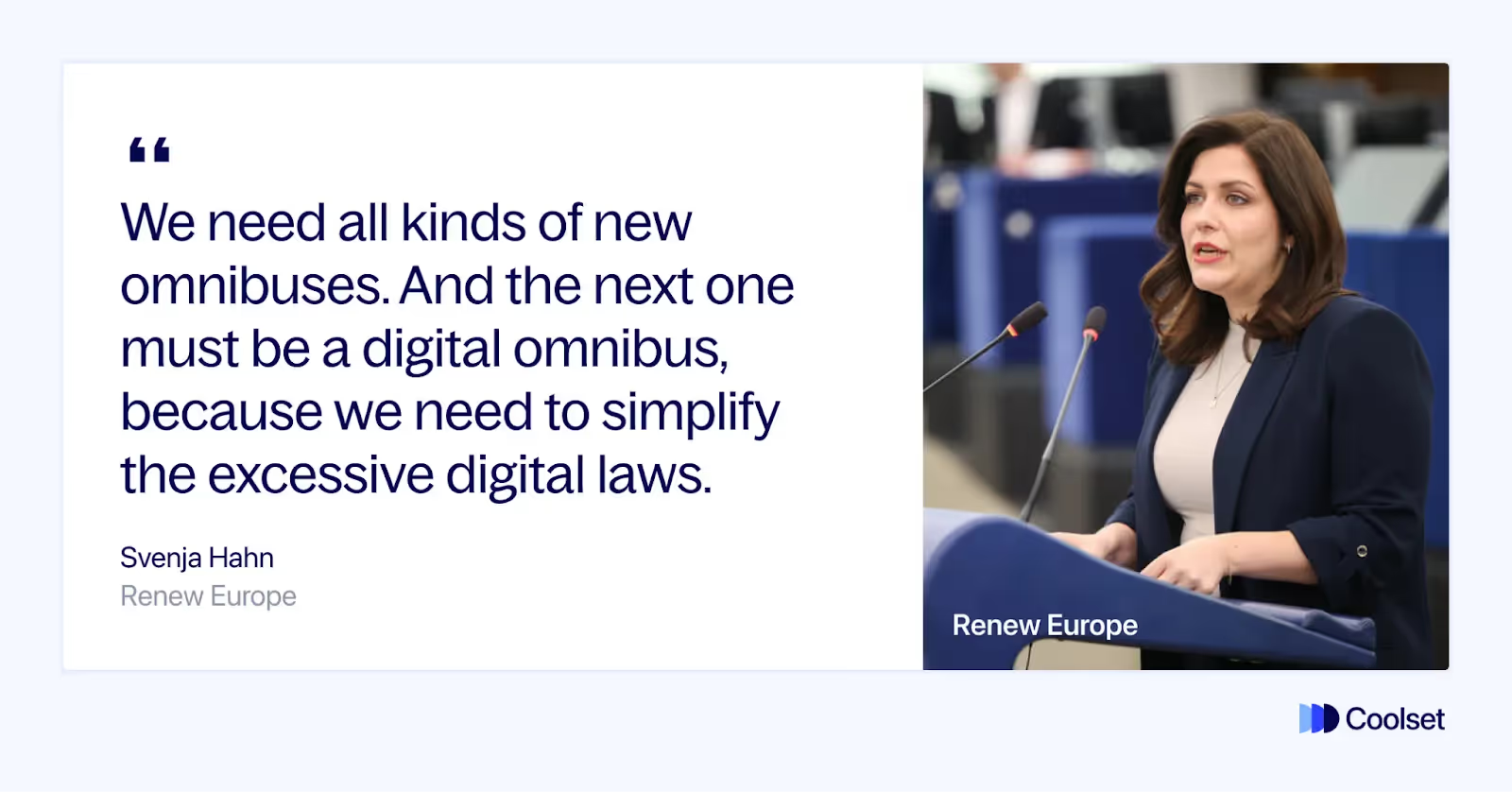
The 53-seat Greens are the strongest defenders of ESG ambition, warning that the Omnibus risks becoming a vehicle for deregulation. It supports simplification only if it doesnʼt weaken ESG impact and insists on keeping CSRD and CSDDD scope broad and effective.
“You’re not reducing bureaucracy – you’re extending impunity. This isn’t simplification. It’s sabotage.” – Marie Toussaint (Greens)
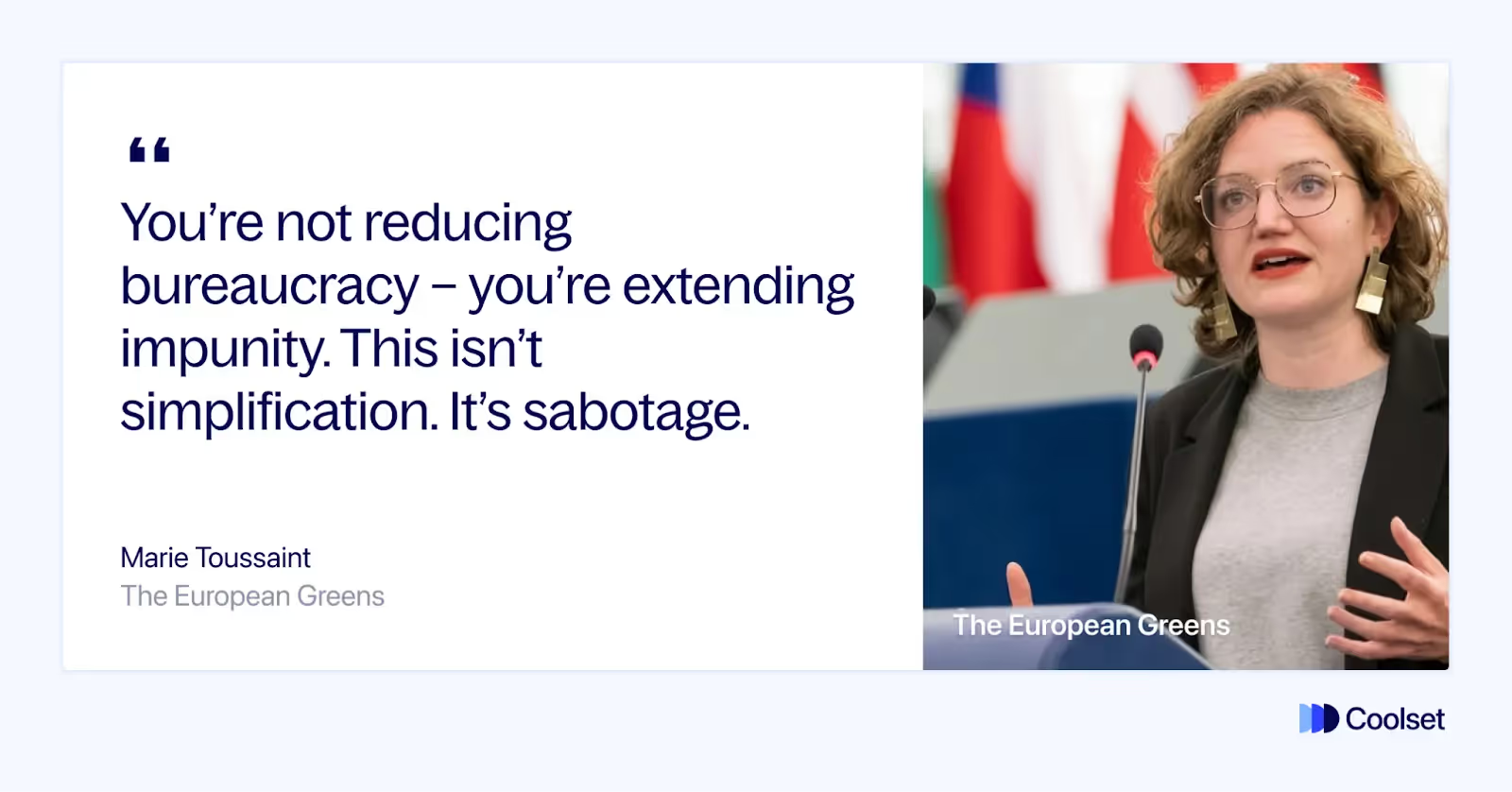
To better understand the political dynamics surrounding the Omnibus Proposal, the Coolset team also spoke with Kira Marie Peter-Hansen, Vice President of the European Greens and shadow rapporteur in the JURI committee (Legal Affairs).
Rather than reopening legislation, Peter-Hansen argued the Commission could have made adjustments through Level 2 acts. This would have avoided the confusion and legal uncertainty now facing many businesses.
Reopening the CSRD, CSDDD, and EU Taxonomy, she said, has led to instability and wasted taxpayer funds.
She also flagged several red lines for the Greens:
Peter-Hansen also criticised how the proposal was developed. The process was finalised in under four months (unusually fast for legislation of this scale) and lacked a proper impact assessment.
Most businesses consulted were large corporations from just five countries (Germany, France, Italy, Spain, and the Netherlands). And only 15% of consulted companies were SMEs, despite making up 99% of EU businesses.
A formal complaint has since been filed with the European Ombudsman. It alleges that business lobby groups such as MEDEF, BDI, and Confindustria had their demands incorporated almost verbatim into the draft proposal.
Peter-Hansen pointed to Sweden’s outsized influence in shaping the Omnibus. The lead rapporteur for JURI, Jörgen Warborn, the ENVI rapporteur, and a key EPP vice president, Tomas Tobé, are all Swedish.
The broader negotiation team made up of MEPs from Denmark, the Netherlands, France, and Sweden represents a relatively narrow cross-section of the EU for such a significant legislative reform.
Despite her concerns, Peter-Hansen encouraged companies not to disengage. The Omnibus is still a proposal, and there’s a window of opportunity to raise concerns and help shape the final legislation. As she put it: “The green transition is a long-term certainty.”
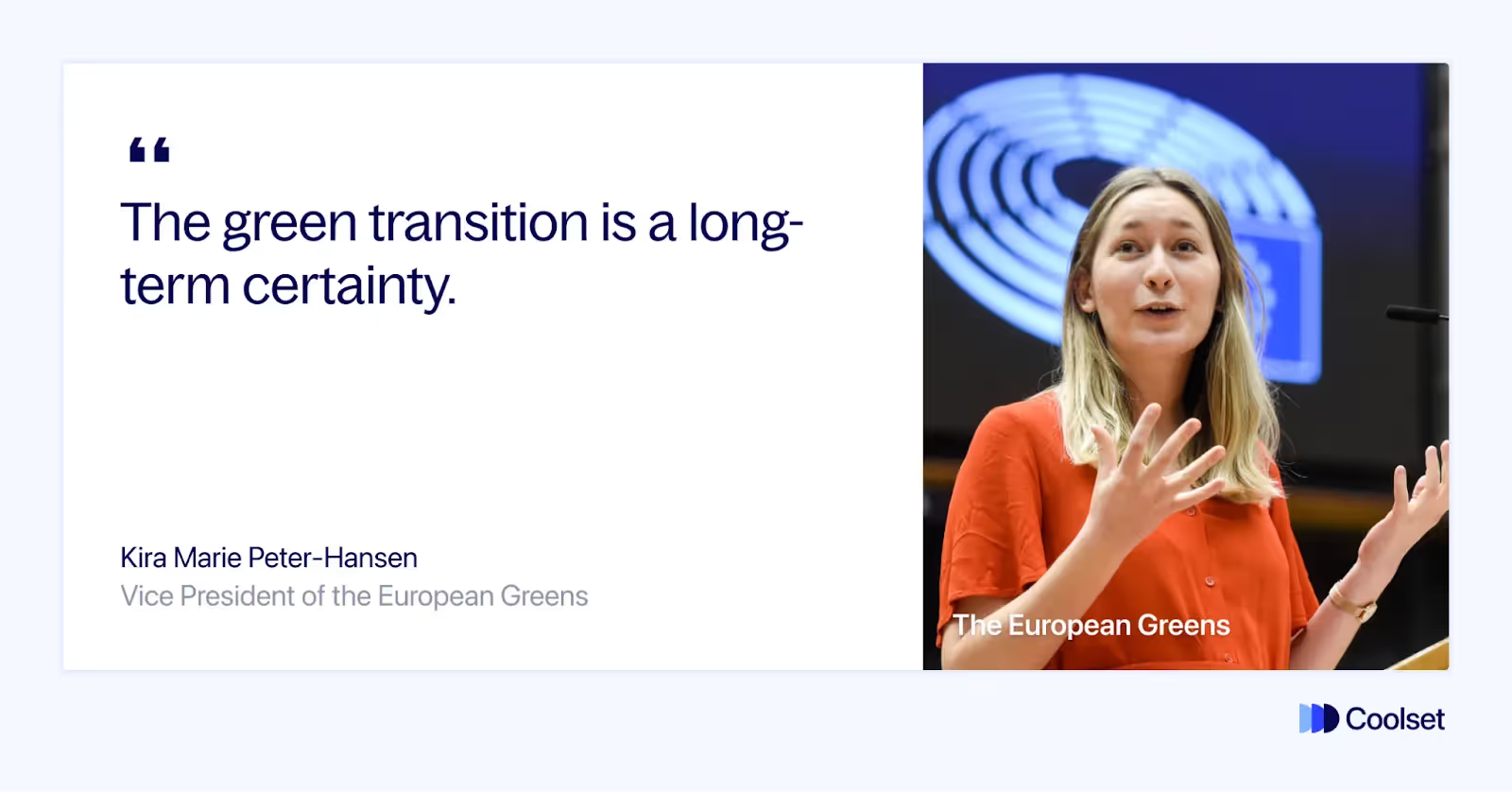
Regardless of where the Omnibus lands, companies can’t afford to sit still. The political process may be turbulent, but the long-term direction, toward more transparency and sustainability, isn’t going anywhere.
Here’s how your business can stay prepared and proactive:
Start by understanding exactly where your company stands. Review the current and proposed scopes of EU sustainability laws CSRD, CSDDD, the EU Taxonomy, and the VSME standard.
Are you still in scope? In a grey zone? Exempt for now? Regardless of status, the message is clear: don’t stop generating ESG data.
Use the current “pause” strategically. This is the moment to fix internal inefficiencies, standardize your data, and establish clear audit trails.
Choose flexible, scalable tools like Coolset that can adjust as the rules evolve, without starting from scratch each time.
Even if your company isn’t obligated to report yet, a rehearsal round can highlight gaps. In Q3, focus on your core data infrastructure: your double materiality assessment, ESRS general disclosures, and Scope 1-3 estimates. Updated datapoint guidance is expected by October, with a 30–50% reduction in requirements.
In Q4, it’s worth simulating a full ESRS disclosure to get ahead.
Now’s the time to define your science-based targets, map emissions hotspots, and outline concrete steps for reducing your footprint. Tie the plan to real incentives. Linking it to executive remuneration and budgeting will help embed it into core operations.
ESG can’t be siloed. Revisit your materiality assessment and ensure it’s connected to business strategy. Finance, legal, and comms teams should be aligned on what ESG means for your business and how it’s communicated internally and externally.
The Omnibus is still in flux, and that means businesses have a voice. Reach out to your country’s EU representatives, engage with MEPs on relevant committees, and join consultations. Whether directly or through business coalitions, your input still matters.
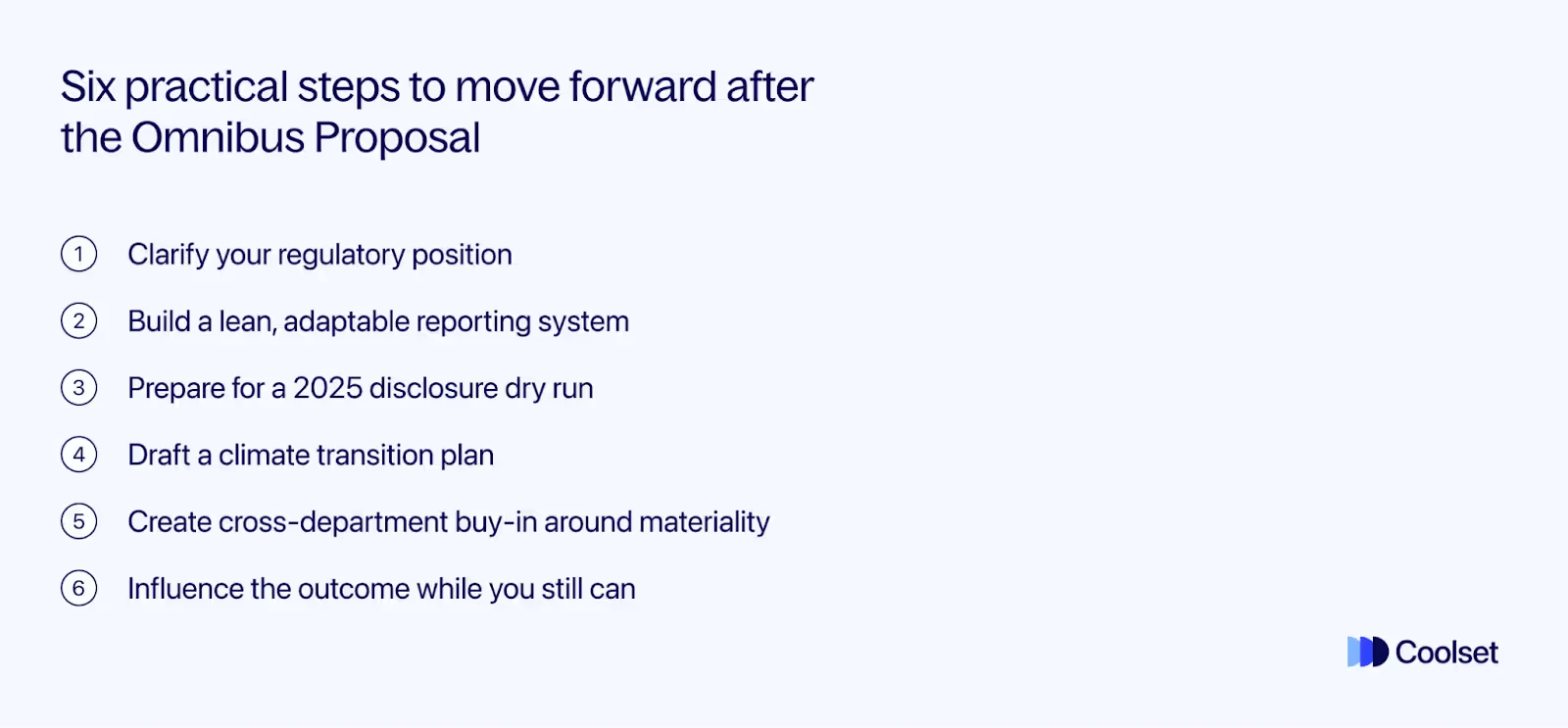
Three months in, the Omnibus Proposal has created more questions than answers. But if there’s one thing we’re sure of, it’s that ESG reporting isn’t going anywhere, it’s evolving.
Political negotiations may shape the final outcome, but market expectations, investor pressure, and climate realities continue to move in one direction.
Rather than waiting for clarity, now’s the time to act with intention. Understand your position, streamline your reporting, and stay engaged. The companies that treat this moment as an opportunity will be the ones best positioned to adapt, influence, and lead in a fast-changing regulatory landscape.
At Coolset, we’re here to help you do exactly that, with tools and guidance built for mid-sized businesses navigating the complexity of EU sustainability rules. If you’re unsure what the Omnibus means for your company, or how to move forward with confidence, we’re just a conversation away.
The Omnibus Proposal is a legislative package introduced by the European Commission in February 2025 to simplify EU sustainability rules. It proposes major rollbacks to existing frameworks like the CSRD, EU Taxonomy, and CSDDD.
The original CSRD applied to companies with over 250 employees. Under the Omnibus, that threshold could rise to 1,000 or even 5,000 employees. This would shrink the number of in-scope companies from ~50,000 to under 7,0003 months into Omnibus. Even though some companies may be exempt from mandatory CSRD disclosures, 90% of businesses surveyed still plan to continue ESG reporting to meet stakeholder expectations and protect credibility3 months into Omnibus.
Double materiality, a CSRD cornerstone, is being reconsidered. Streamlining is expected, potentially making the materiality process simpler and more focused- but final details are still emerging3 months into Omnibus.
A final decision is expected as early as late 2025. This is unusually fast for legislation of this scale, and negotiations between political parties are still ongoing3 months into Omnibus.
Businesses should:
Find out what has changed and what your company needs to know as of June 2025.
%20(1).avif)